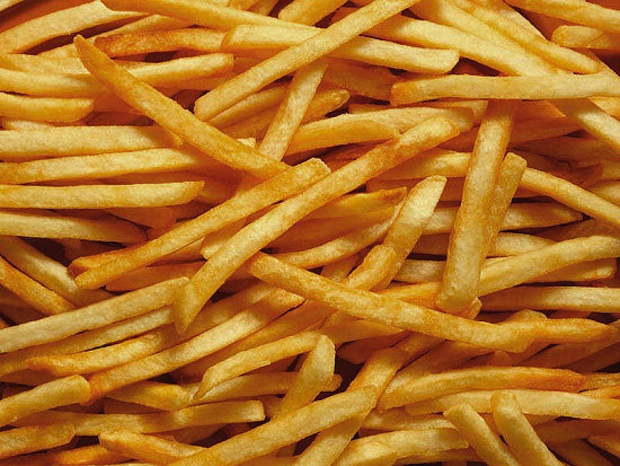Have you all seen/heard the latest ad by Wendy's all over the media? "Try Wendy's New Natural Cut French Fries with Sea Salt?" This is the latest attempt by the fast food industry to try throw buzz words at the public to get the perception that a new item is healthy when in fact it is not.
1. "Natural Cut" has nothing to do with the product's ingredients, it is merely referring to the look of the product. They have decided to leave some of the skin on, and the thickness of the fries has changed.
2. These fries are ANYTHING but natural. Dextrose (also known as SUGAR) is the 3rd ingredient. These "Natural Cut" French Fries undergo several treatments,which include being sprayed with a chemical called Sodium Acid Pyrophosphate (the 4th ingredient listed), which prevents the potatoes from browning during the two deep frying sessions they go through (once at the factory and once again at the restaurant).
3. Another unnatural ingredient called Dimethylpolysiloxane, can be found in these "Natural Cut French Fries with Sea Salt". Dimethylpolysiloxane is a silicone based anti-foaming agent is added to the fries that helps to stabilize the frying oil, which would otherwise become foamy after repeated uses.
4. Then there is the salt. Sea salt and table salt have the same basic nutritional value — both mostly consist of two minerals — sodium (Na) and chloride (Cl). Sea salt is not any healthier than regular salt. However, sea salt is often marketed as a more natural and healthy alternative. The real differences between sea salt and table salt are in their text, taste and processing, not their chemical makeup. Table salt is more heavily processed to eliminate trace minerals and usually contains an additional additive to help prevent clumping. Most table salt also has added iodine. Sea salt produced through evaporation of seawater, usually with little to no processing. Some trace minerals and elements are left behind depending on the water source.
A medium sized portion of this product (142g) still has 500 mg of Sodium. Just for comparison McDonald's Medium Fries (117g) have 270 mg of Sodium while their large sized fries (154 g) has 350 mg of sodium.
5. Finally, just for the finally dose of reality: a medium sized portion of these fries has 420 kcals and 20 grams of fat. Wendy's Nutrition
As you can see, what a company may call "Natural" may not be so "Natural".......
This interactive blog is a place to discuss the latest food, nutrition and health information; to learn tips and strategies for maintaining good health or reaching your own health goal. Please send all questions regarding nutrition and health for discussion on this blog.

Monday, April 25, 2011
Thursday, April 21, 2011
Question of the Week: Sugar & Carb Free Diets?
The following question was submitted for discussion on this week's blog post, " I was recently diagnosed with Pre-Diabetes and was wondering how strict my diet really needs to be? Does every meal and snack need to be completely sugar and carb free?"
First, I want to say that's it is great that you want to make some positive changes to your diet. Start with small achievable changes and master those as longtime habits are sometimes difficult to break.
Your meals and snacks should not be carb-free. Carbohydrates play an important part of everyone's diet no matter who you are. Carbohydrates are the main source of energy for your body. The important point that needs to be made is the carbohydrates that you consume should be those considered "healthy carbohydrates" such as fruits and vegetables, low or nonfat dairy products, and whole grains (i.e. quinoa, brown rice, wheat pasta, multigrain bread).
Unhealthier choices of carbohydrates are those that should be limited or eliminated. This category consists of items that are usually calorie dense yet lack the proper nutrients. These "unhealthier" carbohydrates include choices such as baked goods, white rice, white pasta, and white bread.
Healthy carbohydrate choices should consist of approximately 45-65% of your total daily caloric intake. For example, if your intake was 1800 kcals for the day, calories from carbohydrate should range from between 810 kcals and 1170 kcals. Keep an eye on portion sizes to keep your calories in check.
First, I want to say that's it is great that you want to make some positive changes to your diet. Start with small achievable changes and master those as longtime habits are sometimes difficult to break.
Your meals and snacks should not be carb-free. Carbohydrates play an important part of everyone's diet no matter who you are. Carbohydrates are the main source of energy for your body. The important point that needs to be made is the carbohydrates that you consume should be those considered "healthy carbohydrates" such as fruits and vegetables, low or nonfat dairy products, and whole grains (i.e. quinoa, brown rice, wheat pasta, multigrain bread).
Unhealthier choices of carbohydrates are those that should be limited or eliminated. This category consists of items that are usually calorie dense yet lack the proper nutrients. These "unhealthier" carbohydrates include choices such as baked goods, white rice, white pasta, and white bread.
Healthy carbohydrate choices should consist of approximately 45-65% of your total daily caloric intake. For example, if your intake was 1800 kcals for the day, calories from carbohydrate should range from between 810 kcals and 1170 kcals. Keep an eye on portion sizes to keep your calories in check.
Sunday, April 17, 2011
Question of the Week: Fighting the Nightly Sweet Tooth"
The following question was submitted for discussion on this week's blog post: "I have a sweet tooth at night. I like to reward myself after a hard day at work with a bowl of ice cream before bed. Is this ok to do since I now have diabetes? "
It is not uncommon to crave something sweet in the evenings or wanting to reward one's self at the end of a hard day with a sweet treat. Doing this from time to time, in small portions (1/2 Cup), while watching the rest of your daily intake, and while incorporating exercise (30 minutes minimum) into your daily routine should not be an issue. Treats such as these are best for special occasions such as social gatherings.
If you choose ice cream as a treat, there are many types available that are low fat (sometimes marketed as "slow churned"), low calorie (such as Weight Watchers or Skinny Cow), and there are no-sugar added varieties frozen treats available. There are also many very delicious varieties of frozen yogurt available that are a healthier alternative to full-fat ice cream. Keep in mind that despite the fact that these aforementioned alternatives are healthier choices, you still need to adhere to the 1/2 Cup portion guideline.
Avoid high calorie/fat/sugar toppings for your frozen dessert. Whipped Cream, syrups, sauces, and sprinkles will add more calories, fat, and carbohydrates without any nutritional value.
It is not uncommon to crave something sweet in the evenings or wanting to reward one's self at the end of a hard day with a sweet treat. Doing this from time to time, in small portions (1/2 Cup), while watching the rest of your daily intake, and while incorporating exercise (30 minutes minimum) into your daily routine should not be an issue. Treats such as these are best for special occasions such as social gatherings.
If you choose ice cream as a treat, there are many types available that are low fat (sometimes marketed as "slow churned"), low calorie (such as Weight Watchers or Skinny Cow), and there are no-sugar added varieties frozen treats available. There are also many very delicious varieties of frozen yogurt available that are a healthier alternative to full-fat ice cream. Keep in mind that despite the fact that these aforementioned alternatives are healthier choices, you still need to adhere to the 1/2 Cup portion guideline.
Avoid high calorie/fat/sugar toppings for your frozen dessert. Whipped Cream, syrups, sauces, and sprinkles will add more calories, fat, and carbohydrates without any nutritional value.
Wednesday, April 6, 2011
Question of the week: Ordering Healthy at a Sandwich Shop
The following question was submitted for discussion on this week's blog posting: "On my lunch breaks I go to a sandwich shop. I usually get a large deluxe sandwich with a side of potato salad or coleslaw. Now that I have diabetes, I’m trying to modify my lunch order. Can you make some suggestions of what to order?"
There are many delicious menu items that you can still order from a sandwich shop despite your recent diagnosis. Here are some suggestions for modifying your order to make it "healthier":
1. Instead of having your sandwich on a hoagie roll, choose whole wheat or multigrain bread. If you make it an open-faced sandwich to eliminate some of the excess bread, even better!
2. Choose a lean meat such turkey breast, roast beef, or chicken breast. Avoid processed meats like bologna and salami. Choose low sodium varieties when available. Try to keep to 3 - 4 oz of meat on your sandwich (put the rest of it aside to make another sandwich or for lunch the following day).
3. If cheese is a must - choose a low fat, low sodium variety. Watch your portion. Try to limit to one slice of cheese (for flavor).
4. Bulk up with veggies. Load up your sandwich with lettuce, tomato, cucumber slices, and green pepper rings. This is a great way to get your "5 a Day" and feel full without the extra calories and fat. Be creative, ask for spinach instead of iceberg lettuce!
5. Skip the chips, potato, macaroni, or pasta salads. Opt for a side garden salad with a light dressing on the side. If you aren't in the mood for salad, choose a broth based soup (1/2 cup).
6. Pass on the Mayo: Choose mustard or ripe avocado to spread on your sandwich.
7. Watch your portions - If your sandwich is big - Eat half, save half!
There are many delicious menu items that you can still order from a sandwich shop despite your recent diagnosis. Here are some suggestions for modifying your order to make it "healthier":
1. Instead of having your sandwich on a hoagie roll, choose whole wheat or multigrain bread. If you make it an open-faced sandwich to eliminate some of the excess bread, even better!
2. Choose a lean meat such turkey breast, roast beef, or chicken breast. Avoid processed meats like bologna and salami. Choose low sodium varieties when available. Try to keep to 3 - 4 oz of meat on your sandwich (put the rest of it aside to make another sandwich or for lunch the following day).
3. If cheese is a must - choose a low fat, low sodium variety. Watch your portion. Try to limit to one slice of cheese (for flavor).
4. Bulk up with veggies. Load up your sandwich with lettuce, tomato, cucumber slices, and green pepper rings. This is a great way to get your "5 a Day" and feel full without the extra calories and fat. Be creative, ask for spinach instead of iceberg lettuce!
5. Skip the chips, potato, macaroni, or pasta salads. Opt for a side garden salad with a light dressing on the side. If you aren't in the mood for salad, choose a broth based soup (1/2 cup).
6. Pass on the Mayo: Choose mustard or ripe avocado to spread on your sandwich.
7. Watch your portions - If your sandwich is big - Eat half, save half!
Labels:
deli; sandwich; quick lunch,
healthy
Subscribe to:
Posts (Atom)



